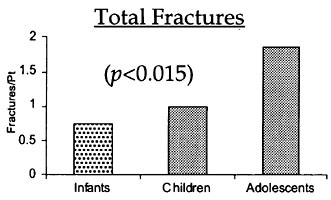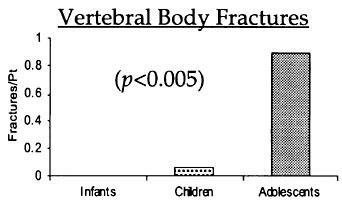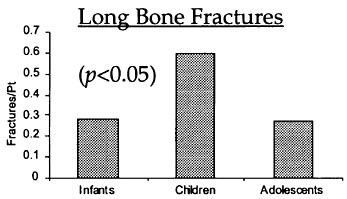
Session VII - Pediatrics
Fracture Patterns in Children and Young Adults Who Fall from Significant Heights
Jeffrey R. Sawyer, MD; John M. Flynn, MD; John P. Dormans, MD; John Catalano, MD; Denis S. Drummond, MD, The Campbell Clinic, Memphis, TN; Children's Hospital of Philadelphia, Philadelphia, PA
Purpose: Trauma is the leading cause of morbidity and mortality for children and young adults less than 40 years of age, with falls being the most common mechanism of injury. Fall-related injuries are a result of a complex interaction between the physiologic factors of the victim as well as the physical factors of the fall. This study was performed to investigate if children, who are physiologically different from adults in many ways including weight distribution, body composition and neurologic development, display different patterns of fracture following falls from significant heights.
Methods: We retrospectively reviewed the medical records and appropriate radiographs for 110 consecutive patients, 21 years of age or younger who were admitted to one of three level I trauma centers from 1992-1997 as a result of a fall from a height of 10 feet or greater. Patients were divided into three groups based on age. There were 25 patients in the infant/toddler group (0-2 years), 55 in the children group (3-10 years) and 30 in the adolescent/young adult group (11-21 years). The hospital charts and appropriate radiographs were reviewed for patient age, height and location of fall, landing surface, fractures, and hospital length of stay. The groups were then compared using ANOVA with a level of significance of p< 0.05.
Results: We found statistically significant differences in the fracture distributions between the three groups. The adolescent/young adult group sustained a greater number of vertebral body (p<0.005) as well as total number of fractures (p<0.015) per fall than the other two groups. The children group, in contrast, had a significantly increased number of long- bone fractures as compared to the other two groups (p<0.05). (Figure 1.) In addition, no significant relationship was found between fall height, fall location or landing surface and subsequent fracture pattern.
Conclusions: This study, to the best of our knowledge, is the first to demonstrate age-related patterns of fracture following falls from a significant height. Knowledge of these age-related patterns of fracture will result in more rapid and accurate diagnosis of these injuries, which are often delayed or missed in diagnosis. In addition, increased awareness of these highly preventable injuries may aid in the efforts to decrease trauma-related morbidity and mortality in children, which is currently of epidemic proportions.


